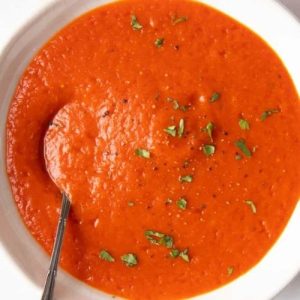This vibrant Red Pepper and Tomato Soup is a quick, comforting, and nutritious meal that bursts with natural flavors.
Packed with fiber, plant-based protein, and low in saturated fat, it’s perfect for a healthy lifestyle.
Easy to prepare and ideal for meal prep, this soup is both satisfying and versatile, making it a go-to choice for everyday cooking.

Healthy Tomato Pepper Soup
Equipment
- 1 chopping board
- 1 knife
- 1 roasting tin
- 1 blender
Ingredients
- 500 g large vine tomatoes
- 3 red bell peppers
- 1 stock cube or 1 stock pot
- 1 yellow onion
- 3 garlic cloves whole, unpeeled
Instructions
- Prepare the Vegetables: Begin by gathering your fresh produce. Place the vine tomatoes, red bell peppers, and yellow onion on a chopping board. Using a sharp knife, roughly chop the tomatoes into large wedges, slice the peppers in half to remove the seeds and membranes, then cut them into chunks. Finally, peel the onion and cut it into quarters. Keeping the pieces fairly uniform in size will ensure that all vegetables roast evenly in the oven.
- Add the Garlic for Depth: Take the three garlic cloves and leave them unpeeled. This may seem unusual, but roasting garlic in its skin prevents it from burning and helps it soften into a sweet, mellow paste. Place the whole cloves alongside the chopped vegetables. The garlic will infuse the soup with a rich background flavor once blended.
- Arrange on Roasting Tin: Line a roasting tin with parchment paper if desired for easier cleanup. Spread the tomatoes, peppers, onion quarters, and garlic cloves evenly across the tin in a single layer. Avoid overcrowding, as this allows the vegetables to caramelize properly and develop deep, smoky flavors during roasting.
- Roast to Enhance Flavor: Preheat your oven to 200°C (390°F). Place the roasting tin on the middle rack and allow the vegetables to roast for 45 minutes. During this time, the tomatoes will release their natural juices, the peppers will soften and sweeten, and the onions will caramelize beautifully. This slow roasting process is what gives the soup its rich and comforting taste. No additional oil is required, making the soup naturally lighter and lower in fat.
- Cool and Prepare for Blending: Once the vegetables are fully roasted, remove the tray from the oven and set it aside for a few minutes to cool slightly. Take each roasted garlic clove and gently squeeze from the base—the soft, golden paste inside will slip out easily, leaving the papery skin behind. Discard the skins and keep the sweet roasted garlic for blending.
- Blend into a Silky Soup: Transfer the roasted tomatoes, peppers, onion, and garlic paste into a high-speed blender. Add the stock cube (or stock pot) along with about 300 ml (1 ¼ cups) of hot water to start. Blend on high until the mixture is completely smooth and velvety in texture. If the soup is too thick, gradually add more water until you reach your desired consistency. Taste and adjust seasoning if needed—though the roasted vegetables often provide enough natural sweetness and balance.
- Serve and Enjoy Immediately: Once blended, pour the hot soup into bowls and serve right away. For a simple garnish, drizzle with a touch of olive oil, sprinkle with cracked black pepper, or top with fresh basil leaves. Pair it with a slice of crusty bread or a light side salad for a wholesome, filling meal.
- Save for Later (Optional): If you have leftovers, allow the soup to cool completely before transferring it to an airtight container. Store it in the refrigerator for up to 3 days or freeze it for up to 3 months. When reheating, simply warm it gently on the stovetop or in the microwave, adding a splash of water if needed to loosen the texture.
Notes
- Roasting the vegetables brings out deep, naturally sweet flavors that make this soup rich and satisfying.
- Garlic roasted in its skin turns soft, buttery, and blends smoothly into the soup without bitterness.
- The recipe is naturally oil-free, keeping it light and healthy without compromising taste.
- You can easily adjust the consistency—add more stock for a thinner soup or keep it thick and hearty.
- Spice levels are flexible; add chili flakes, paprika, or cayenne if you prefer extra heat.
- Toppings like croutons, fresh herbs, or a swirl of cream (or coconut milk) add variety and flair.
- Perfect for meal prep—make a big batch, refrigerate for 3 days, or freeze for up to 3 months.
- Works as both a light starter and a wholesome main when paired with bread, salad, or protein.
Chef’s Secrets for Best Results
The magic of this soup lies in the roasting step. Take your time here—the longer the vegetables roast, the more caramelization and depth of flavor you’ll achieve.
Cutting the vegetables into roughly equal sizes ensures even cooking and prevents burning.
Always keep the garlic in its skin; this protects it from bitterness and results in a silky, nutty taste when blended.
Another trick is to add the stock gradually while blending. This allows you to control the thickness and keep the soup velvety instead of watery.
For an elevated flavor, try blending in a pinch of smoked paprika or a dash of balsamic vinegar at the end—it enhances the natural sweetness and adds a gourmet touch.
Serving Suggestions for Every Occasion
This soup is incredibly versatile and pairs well with a variety of sides.
For a cozy weeknight dinner, serve it with warm crusty bread or a grilled cheese sandwich. If you prefer something lighter, pair it with a crisp green salad topped with chickpeas or avocado for added protein.
For an elegant starter at a dinner party, drizzle the soup with a swirl of cream or coconut milk and garnish with fresh herbs.
You can also top it with crunchy croutons, pumpkin seeds, or a sprinkle of nutritional yeast for added texture and nutrition.
Whether enjoyed as a light lunch or a hearty dinner, this soup adapts beautifully to every occasion.
Storage Tips for Freshness Retained
To keep your soup tasting as fresh as possible, always allow it to cool completely before transferring it to an airtight container.
In the refrigerator, it will last for up to three days, and the flavors often deepen by the next day.
For longer storage, freeze the soup in individual portions for up to three months—this makes reheating simple and convenient for quick meals.
When reheating, thaw overnight in the fridge or heat directly from frozen on low heat, stirring occasionally to prevent sticking.
If the texture thickens too much after storage, simply add a splash of water or vegetable stock to bring it back to the perfect consistency.
Frequently Asked Questions
1. Can I use canned tomatoes instead of fresh?
Yes, you can substitute canned tomatoes if fresh ones aren’t available.
However, roasting fresh vine tomatoes adds a natural sweetness and depth of flavor that canned versions can’t fully replicate.
If using canned, choose whole peeled tomatoes and roast them with the peppers and onion for the best results.
2. How can I make the soup spicier?
To add a bit of heat, roast one red chili pepper alongside the vegetables or blend in a pinch of cayenne pepper or red chili flakes.
Start small, as the flavors intensify after blending, and adjust according to your preference.
3. Can I make this soup without a blender?
If you don’t have a blender, you can use a hand-held immersion blender directly in the pot or even a food processor.
For a more rustic texture, you can mash the vegetables with a potato masher after roasting, though the soup will be chunkier rather than silky smooth.
4. What protein can I add for a fuller meal?
This soup pairs beautifully with plant-based proteins such as lentils, chickpeas, or white beans.
You can blend them directly into the soup for creaminess or add them afterward for extra texture and heartiness.
For non-vegetarian options, shredded chicken works well too.
5. How can I make the soup creamier without dairy?
For a dairy-free creamy texture, stir in coconut milk, cashew cream, or even a spoonful of hummus at the end of blending.
These additions enhance the richness without overpowering the roasted vegetable flavors.

